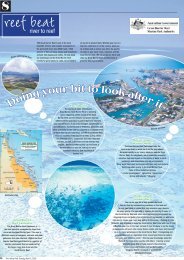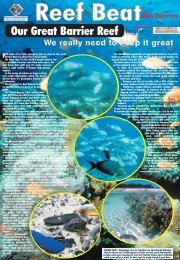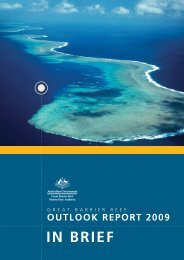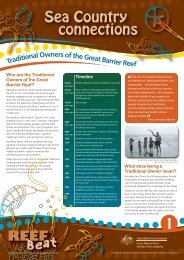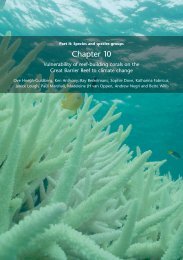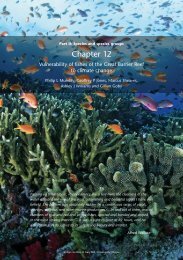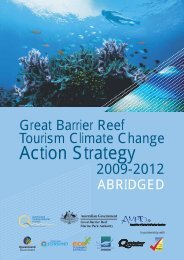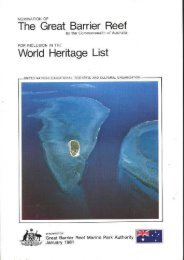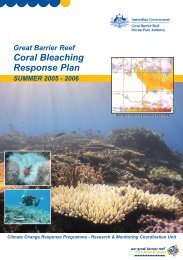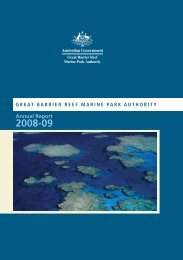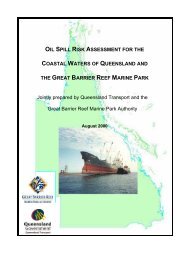ACTIVITIES BOOK - Great Barrier Reef Marine Park Authority
ACTIVITIES BOOK - Great Barrier Reef Marine Park Authority
ACTIVITIES BOOK - Great Barrier Reef Marine Park Authority
You also want an ePaper? Increase the reach of your titles
YUMPU automatically turns print PDFs into web optimized ePapers that Google loves.
Break the class into pairs. Each pair is a ‘reef’. Ask students to name their reef. Shuffle the action cards anddistribute them equally to the reefs (try to give each team at least three actions). Give each team at least onereef regeneration card to use whenever they like (this is like a wild card that can be played at any time tohelp their reef regenerate). In each round a member of the team leaves to collect an impact card and bring itback to the team. The pair then determines whether or not they have an appropriate action to combat theimpact. If the reef does not have an action card that is relevant to the current impact, part of the reef dies (i.e.one student sits down). The second time a reef is impacted, it dies completely and the second student sitsdown. <strong>Reef</strong>s can be regenerated using the reef regeneration cards (by turning a card into the teacher thereef can get one student back). In the first round, reefs are isolated and cannot help each other. Keep playinguntil there is only one reef left. In the second round, reefs may assist each other by sharing action cards (thisis similar to how neighbouring reefs can help each other regenerate after an impact by ‘sharing’ baby corals,fish and other marine life). In the third round you may wish to create a supergroup – a network of reefs thatcan all assist each other when an impact happens. This shows how a larger reef is more resilient than asmaller reef.Discussion: Discuss what happened during the game. What damaged reefs? What helped reefsregenerate? Why were healthy reefs more resilient to impacts? (e.g. because they had two students so whendamage occurred, part of the reef remained healthy). Why were networks of reefs more resilient in the game?Why are networks of reefs more resilient in reality? (e.g. because they share baby corals and animals toregenerate populations). What were the impacts of both negative and positive human actions on the reefs inthis game? How is this similar on real reefs? What did you learn from the game?Activity 3: <strong>Reef</strong> resilience dramaKey learning objective: Students will visualise the concept of reef resilience by creating andpresenting a dramatic interpretation of resilience. This activity will require students to use acreative approach to interpret what resilience means for coral reefs. Students will understand howreefs are damaged and bounce back from damage and the role of human actions in this process.Background: Students should have an awareness of the fine balance that exists in a coral reefecosystem. This balance can be upset by disturbance, but if the reef is healthy and resilient, thereef can bounce back to health. Students should be aware of impacts that can damage reefs andactions that can assist with reef recovery. The previous activity is a good segue into exercise.What you will need:1. coloured pens2. paints3. paper masks (use <strong>Reef</strong>ED ones or make your own)4. elastic to hold the masks on5. costumesInstructions:Bright idea: Using theglossary provided, havestudents come up withreal life examples ofresilience, symbioticrelationships, adaptive management,or any other words or terms youchoose.• Discuss what resilience is and how a healthy reef can bounce backfrom a natural disturbance such as a cyclone, a heat wave or a flood.• Discuss the impacts humans can have on coral reefs and ask the students if they think reefs areresilient to human impacts.• Ask students to write a story or produce a play, interpretive dance, or other dramatic production thatdepicts reef resilience including impacts and regeneration. This could involve human-related impactsand positive actions and/or environmental impacts.• The students may create masks or use costumes to represent different characters in the story.• The stories could contain a message about resilience or what people can do to make reefs moreresilient.• Stage the play at assembly, parade, or to a group of parents in order to explain to your school andcommunity what we can all do to help improve the resilience on the <strong>Great</strong> <strong>Barrier</strong> <strong>Reef</strong>.Discussion: Ask students what they learned from this production. What kind of things impact reefs? Whatkind of things help reefs regenerate? What is the role of humans in this cycle? Ask students what messagesthey tried to convey in their creative production and why. Discuss other ways of helping the rest of the schoolor community understand the complex concept of resilience and how it applies to coral reefs.29<strong>Reef</strong> Beat 2009 - Climate Change and the <strong>Reef</strong>



